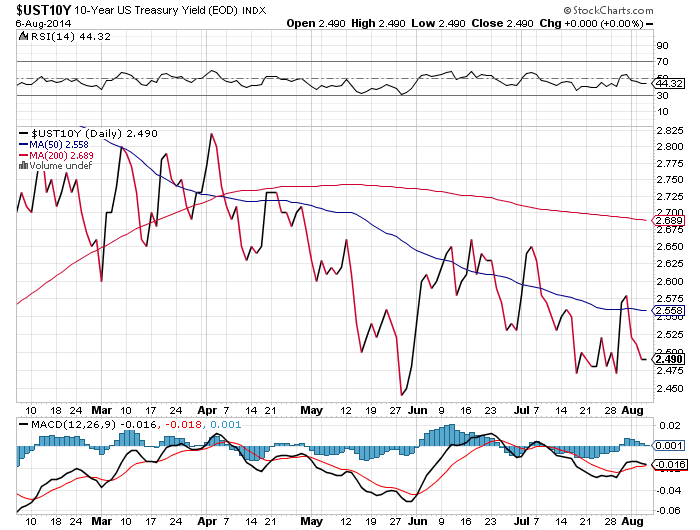Late last month I wondered if lower yields were signaling higher risk? The question still resonates. Indeed, the benchmark 10-year Treasury yield is under 2.50% again, or near the lowest levels for the past year. This is a bit odd because US economic data continues to trend positive, although the housing sector still looks wobbly. Nonetheless, nonfarm payrolls and other major macro indicators betray no conspicuous warning signs at this time. In turn, the moderately upbeat profile on the economy suggests that the Fed will continue to wind down its quantitative easing program in the autumn, which lays the groundwork for raising interest rates next year. But there are risks bubbling around the world that are weighing on interest rates and so demand is rising for a safe haven in the world’s reserve currency.
“It’s been a difficult trade for most participants as economic fundamentals battle against geopolitical stuff,” a Treasury trader at UFJ Securities USA told Bloomberg yesterday. “It’s the fear of the Russia and Ukraine situation escalating. Unless you feel the economy will not recover, rates are too low.”
Earlier this week, Abigail Doolittle at Peak Theories Research noted the return of the so-called Death Cross for the 10-year Note—the recent decline of the 50-day moving average below the 200-day average for the 10-year yield:
In the case of the 10-year yield, however, this is actually a bullish signal for bonds with price trading inverse to yield as investors pile into the safety of Treasurys. Not surprisingly, many of those same investors “pile out” of riskier stocks as shown by the long black arrows pointing to the formal corrections that have occurred after or around the 10-year’s recent Death Crosses.
Put otherwise, the 10-year yield’s Death Cross has proven to be a pretty significant risk-off shot across the bow over the last decade and this is true before, during and after the Fed’s rounds accommodation.
In early trading today (Thursday), the downward momentum on yields rolls on. Bloomberg reports that the 10-year yield slipped to 2.45% in London trading:
“The market is opening up with a strong bid in reaction to bunds,” said Craig Collins, managing director of rates trading at Bank of Montreal in London, referring to German bonds. “The geopolitical situation is outweighing the better data we saw in the middle of last week. We’ll have to see a continuation of stronger data to get” 10-year rates above 2.5 percent, he said.
Risk-off, it seems, is on again.
On an upbeat note, the Treasury market’s inflation forecast has remained relatively steady in the low-2% range. That’s an encouraging sign in that the market anticipates that disinflation/deflation risk remains low. In turn, that’s a clue for thinking that the latest rush into the safety of Treasuries is closely linked with offshore geopolitical risk, along with rising concerns about what it means for economic activity in Europe. Indeed, this week’s news that Italy has slipped back into recession raises a new macro threat for the Continent. Now-Casting.com’s current estimate of second-quarter GDP (scheduled for release next week) for the 18 countries that comprise the Eurozone is a sluggish 0.21% on a quarter-over-quarter basis. That’s about half as much as the estimate from early May.
As for the US macro picture, the moderately positively trend rolls on, as recent numbers suggest (see here and here). It’s easy to think otherwise based on the bond market at the moment. The real danger: the geopolitical threats stalking Europe and elsewhere begin taking a toll on the US macro trend. No sign of that tipping point now, but vigilance in monitoring the trend is essential in this dangerous summer.
